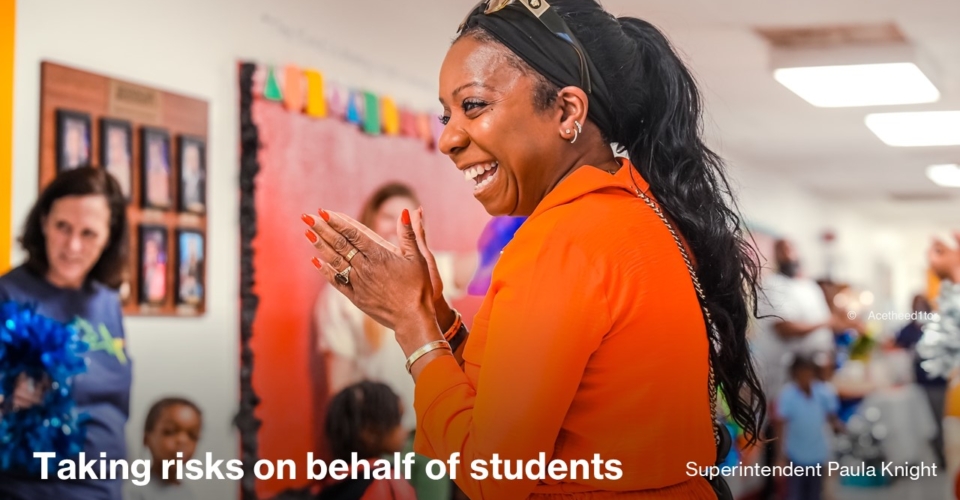When we learned that “rigor” was rated the least popular buzzword among teachers in a recent poll, we weren’t surprised. Throughout our years working with educators, we’ve seen how this term can create anxiety rather than inspiration.
But what if administrators and teachers could collaborate to transform this dreaded word into something that energizes and empowers? We believe they can—by defining rigor in actionable and observable terms that teachers can embrace in their daily practice.
The RIGOR framework: A new perspective
In our work with thousands of teachers across the country, we’ve developed a framework that makes rigor accessible and achievable. “RIGOR” isn’t just another acronym—it’s a pathway to creating meaningful learning experiences through relationships, instruction, goals, organization and relevance.
Here’s what each component looks like in action.
R for relationships: Creating a safe space for risk-taking
Teachers often tell students, “We’re here to support you to do hard things.” This simple statement encapsulates the heart of the first R in our framework. Building strong relationships means creating an environment where teachers and students feel secure enough to take intellectual risks.
For teachers, it starts with basic yet powerful practices: greeting every student, learning to pronounce their names correctly and fostering trust through open communication.
The desire to avoid failure and the fear of its consequences—whether real or merely socially ingrained—are significant factors that keep students from experimenting and growing in more creative, self-directed ways. Building and maintaining good relationships in the classroom helps students to overcome that feeling of fear and sets the environment as one where they can learn—rather than one where they feel they’re already supposed to know everything.
When we visit classrooms where relationships are strong, we hear students asking probing questions and speculating about concepts without fear of being wrong. This is our first indicator that rigor is present and working.
I for instruction: Designing for success
In our experience, instruction is the component most familiar to educators, but we encourage teachers to think beyond traditional instructional strategies to focus on instructional design. The key question isn’t just what scaffolds are in place, but how these supports align with high expectations and grade-level goals.
More from DA: Don’t worry, most funding won’t vanish with education department
We’ve found that the most effective indicator of strong instruction is when teachers share success criteria every day and guide students in self-assessment. This enables learners to understand and take ownership of their learning journey.
G for goals: Setting clear expectations
Goal setting can be misinterpreted as something students do, but the process starts in teachers’ professional learning communities. Teams often set easily attainable goals until they have evidence of their own efficacy, which inspires them to further challenge themselves.
To accelerate this process, we suggest using nine-week goal-setting cycles, so that teams reach the point of setting rigorous goals more quickly. Once teachers have set the goals for their class, the learning environment should make those goals visible and accessible to every student.
O for organization: Creating flexible learning spaces
When we talk about organization, we’re referring to more than just neat desks and labeled supplies. We encourage teachers to think about accessibility in new ways.
For instance, we often ask: “Where’s your alphabet poster hung? Can your 5-year-olds actually see it?” These seemingly small details can have a big impact on learning.
In our observations, the best indicator of strong organization is visible in student grouping patterns. We look for flexible arrangements that change frequently and demonstrate a mix of academic and social skills.
R for relevance: Connecting learning to life
We often hear educators talk about preparing students for “the real world,” but we firmly believe that school is the real world. Teachers should be making connections inside and outside the classroom walls.
In our classroom visits, we look for teachers who regularly discuss why students are learning specific content and how it connects to their interests. This is what we call making learning relevant.
Building a culture of collaborative RIGOR
Clear definitions and indicators open up conversations, make room for high expectations, and create a pathway to deliver on those expectations. RIGOR starts with teachers collaborating to prompt each other’s thinking and create a shared vocabulary.
When rigor is framed in actionable and observable terms, it no longer sparks anxiety—it sparks possibility. By working together to define and implement RIGOR through relationships, instruction, goals, organization and relevance, educators can shift the narrative.
Instead of viewing rigor as an overwhelming demand, they can see it as a shared commitment to meaningful, engaging learning. With collaboration at the center, rigor becomes not just achievable but transformative.



